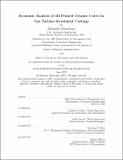Economic Analysis of 3D-Printed Ceramic Cores for GasTurbine Investment Castings
Author(s)
Maristany, Eduardo
DownloadThesis PDF (577.6Kb)
Advisor
Cordero, Zachary
Carrier, John
Terms of use
Metadata
Show full item recordAbstract
When manufacturing blades and vanes for gas turbine engines, internal cooling channels are formed by investment casting with sacrificial ceramic cores. The hot injection and pressing techniques traditionally used to manufacture ceramic cores have long lead times and high up-front costs, motivating an interest to form cores via additive manufacturing. While industrial additive manufacturing technologies enable a faster and more iterative ceramic core manufacturing process, this efficiency comes with high per unit manufacturing costs of additive methods. To determine the quantities for which additive manufacturing is more economical than traditional hot injection and pressing methods, an economic analysis of the aircraft engine and investment casting markets is conducted. Current technical capabilities of several additive methods for forming ceramic cores are compared and Stereolithography and Digital Light Processing are found to be suitable for ceramic core manufacturing. The economic advantage of using viable additive manufacturing methods is assessed using publicly available financial, maintenance, and aircraft fleet size data in a manufacturing cost model. When considering user experience curve effects, the model shows that for a single core design, additive manufacturing is economical at quantities below 1,900 cores, or about 16 high pressure turbine stage sets. When considering multiple core designs needed to satisfy demand across all commercial aircraft in use, the model shows that additive manufacturing is economical at quantities below 720,000 cores, or 14% of the total core market demand in 2019. This motivates the use of additive manufacturing for new core design development and testing as well as the maintenance of older engine designs while reaffirming the use hot injection and pressing techniques for production level manufacturing and maintenance.
Date issued
2023-06Department
Massachusetts Institute of Technology. Department of Aeronautics and Astronautics; Sloan School of ManagementPublisher
Massachusetts Institute of Technology